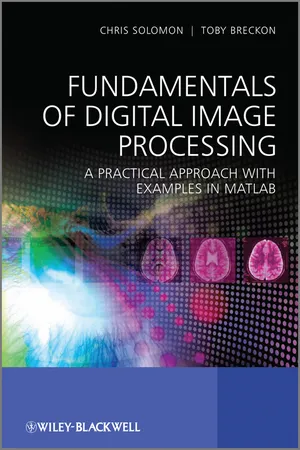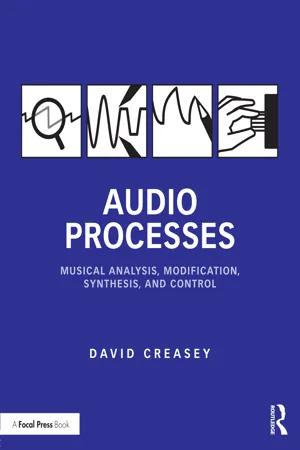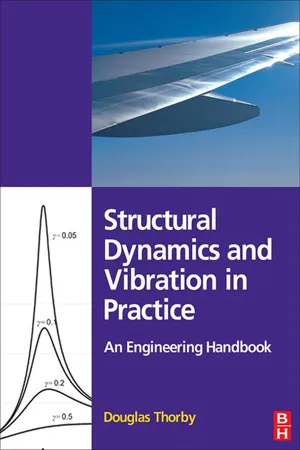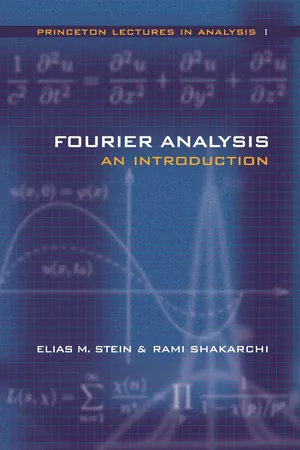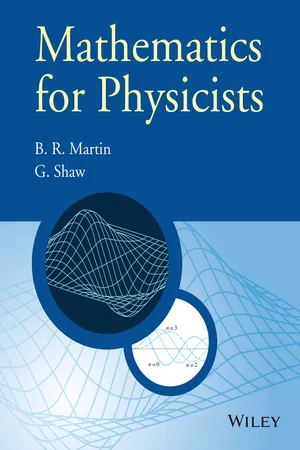Physics
Fourier Analysis Waves
Fourier analysis is a mathematical technique used to break down complex waveforms into simpler components, making it easier to analyze and understand their behavior. It involves expressing a function as a sum of sine and cosine functions with different frequencies and amplitudes. This approach is widely used in physics to study the behavior of waves and signals.
Written by Perlego with AI-assistance
Related key terms
Related key terms
1 of 4
Related key terms
1 of 3
11 Key excerpts on "Fourier Analysis Waves"
- eBook - ePub
Control Theory for Humans
Quantitative Approaches To Modeling Performance
- Richard J. Jagacinski, John M. Flach(Authors)
- 2018(Publication Date)
- CRC Press(Publisher)
12A Qualitative Look at Fourier Analysis
He: So, how long have you been undergoing Fourier analysis?She: Don’t ask how long. Ask how frequently.He: Didn’t you ever get a permanent wave?—AnonymousJean-Baptiste-Joseph Fourier’s Theorie analytique de la chaleur (The Mathematical Theory of Heat) inaugurated simple methods for the solution of boundary-value problems occurring in the conduction of heat. But, this “great mathematical poem,” as Fourier analysis was called by Lord Kelvin, has extended far beyond the physical applications for which it was originally intended. In fact, it has become “an indispensable instrument in the treatment of nearly every recondite question in modern physics,” communication theory, linear systems, etc.—Hsu (1970, preface)Fourier analysis provides a mathematical technique for decomposing signals that extend over time and/or space into a sum of sinusoidal components. As illustrated in Fig. 12.1 , a periodic signal such as a square wave can be approximated by a sum of sinusoidal components. The top of Fig. 12.1 shows the sum of three sinusoids (a sinusoid with the same frequency and 4/π times the amplitude of the square wave plus a sinusoid with 4/3π times the amplitude and three times the frequency of the square wave plus a sinusoid with 4/5π times the amplitude and five times the frequency of the square wave). The bottom of Fig. 12.1 shows the sum of seven sinusoids, the same three as in the top graph plus four more sine waves with higher frequencies. Note that with the addition of the higher frequency components, the sum better approximates the square wave.As noted in chapter 11 , a sine wave has three parameters: a frequency, an amplitude, and a phase. Therefore, if n sine waves have to be added together to approximate a given signal, there are a total of 3n parameters that need to be specified. If n - eBook - ePub
Fundamentals of Digital Image Processing
A Practical Approach with Examples in Matlab
- Chris Solomon, Toby Breckon(Authors)
- 2011(Publication Date)
- Wiley(Publisher)
We will begin our discussion of Fourier methods by summarizing, without any attempt at rigour, some of the key concepts. To stay general, we will talk for the moment of the Fourier analysis of signals rather than images.(1) The harmonic content of signals. The fundamental idea of Fourier analysis is that any signal, be it a function of time, space or any other variables, may be expressed as a weighted linear combination of harmonic (i.e. sine and cosine) functions having different periods or frequencies. These are called the (spatial) frequency components of the signal.(2) The Fourier representation is a complete alternative. In the Fourier representation of a signal as a weighted combination of harmonic functions of different frequencies, the assigned weights constitute the Fourier spectrum. This spectrum extends (in principle) to infinity and any signal can be reproduced to arbitrary accuracy. Thus, the Fourier spectrum is a complete and valid, alternative representation of the signal.(3) Fourier processing concerns the relation between the harmonic content of the output signal to the harmonic content of the input signal. In frequency space, signals are considered as combinations of harmonic signals. Signal processing in frequency space (analysis, synthesis and transformation of signals) is thus concerned with the constituent harmonic content and how these components are preserved, boosted or suppressed by the processing we undertake.These first three concepts are summarized in Figure 5.2 .(4) The space domain and the Fourier domain are reciprocal. In the Fourier representation of a function, harmonic terms with high frequencies (short periods) are needed to construct small-scale (i.e. sharp or rapid) changes in the signal. Conversely, smooth features in the signal can be represented by harmonic terms with low frequencies (long periods). The two domains are thus reciprocal - eBook - ePub
- Philippe Martin(Author)
- 2020(Publication Date)
- Wiley-ISTE(Publisher)
Figure 3.2 ; in other words, by decomposing the waveform into a series of pure harmonic sounds, the addition of which (with their respective phases) restored the original waveform. The idea of decomposing into trigonometric series seems to have already appeared in the 15th Century in India, and would be taken up again in the 17th and 18th Centuries in England and France for the analysis of vibrating strings. In fact, Fourier analysis applies to periodic functions that are infinite in time, and it will therefore be necessary to adapt this constraint to the (hard) reality of the signal, which, far from being infinite, changes continuously with the words of the speaker.To solve this problem, the idea is to sample segments of the sound signal at regular intervals, and to analyze them as if each of these segments were repeated infinitely so as to constitute a periodic phenomenon; the period of which is equal to the duration of the sampled segment. We can thus benefit from the primary interest of Fourier analysis, which is to determine the amplitude of the harmonic components and their phase separately. This is in order to obtain what will appear as an invariant characteristic of the sound with the amplitude alone, whereas the phase is not relevant, and only serves to differentiate the two channels of a stereophonic sound, as perceived by our two ears.The principle of harmonic analysis is based on the calculation of the existing correlation between the analyzed signal and two sinusoidal functions, offset by 90 degrees (π/2); in other words, a correlation with a sine and a cosine. The modulus (the square root of the sum of the squares) of the two results will give the expected response, independently of the phase, which is equal to the arc of the tangent of the ratio of the two components. Mathematically, the two components A and B, of the decomposition of the sampled signal of duration T, are obtained by the following equations: - eBook - ePub
Structural Biology Using Electrons and X-rays
An Introduction for Biologists
- Michael F Moody(Author)
- 2011(Publication Date)
- Academic Press(Publisher)
The 20th century saw two major developments. First, a sound mathematical basis was developed for extending the method to non-repeating curves (called the Fourier transform (FT) as it was originally suggested by Fourier in 1822). Second, the development of computers led to Fourier analysis being very widely used (the digital FT, here introduced in Chapter 4). Fourier analysis is only one example of the general mathematical techniques for analyzing curves in terms of simpler component functions 1. We look at their principles before focusing on the sines and cosines (odd and even sinusoids) used in basic Fourier analysis. However, these sinusoids are mostly used in special ‘complex’ combinations (here called phasors), a complication tackled in section §3.3.2. 1 A simple example is the familiar power series such as e x =1+ x + x ²/2! +… This account aims to introduce the non-mathematical reader to the parts relevant to X-ray diffraction, image analysis and optics; it will use almost entirely intuitive methods. This chapter and the two succeeding ones are confined to 1D FTs for simplicity. A largely intuitive account of Fourier transforms, aimed at crystallographers, is the book by Lipson & Taylor (1958) and Lipson's other books supplement this with optical diffraction patterns. Of the many mathematical accounts of Fourier transforms, Bracewell's (1965–2000) book is specially recommended for comprehensibility (see also his history of the FT: Bracewell (1989)). Bricogne's (2001) modern mathematical account is oriented towards crystallographers. Fourier transforms are useful for both image analysis and also for describing diffraction and wave-optical imaging. All waves involve repeated vibrations, the simplest being sinusoidal; so every signal carried by waves is composed of sinusoids (see Part II). In this Part we concentrate on image analysis. 3.1 - eBook - ePub
Why You Hear What You Hear
An Experiential Approach to Sound, Music, and Psychoacoustics
- Eric J. Heller(Author)
- 2012(Publication Date)
- Princeton University Press(Publisher)
The sinusoidal wave stands alone as the only shape that can be said to comprise a single frequency. This is essentially a tautology, yet it was by no means obvious to even very gifted natural philosophers working before Fourier’s theorem became known. Any nonsinusoidal shape necessarily requires more than one term in its Fourier series.The sinusoid is the fundamental and indivisible unit, the atom, of signal analysis and also of vibration, sound, and music. The sinusoids, each plain and colorless, together can describe any tone or indeed any sound. We shall see this principle in action many times in this book.3.8 Power Spectra
The Fourier decomposition of a periodic signal (for example, a sound trace) into sinusoidal waves can be summarized in an important diagram called a power spectrum. Power is a measure of energy—in fact, the amount of energy per unit time. Across many kinds of waves (light, sound, water, earthquakes), the energy in the wave increases as the square of the amplitude of the wave:Figure 3.18 Power spectrum (right) of the sine trace (left) for the tuning fork; only one frequency at 220 Hz appears. Notice the black dots separated in time by the period T , illustrating y (t ′) = y (f ′ + T ), where here, T = 1/220 second. The power in the wave is proportional to the square of the amplitude.energy α amplitude2 .For water, the amplitude is the height of the wave; for earthquakes, it is the pressure or the shear displacement, depending on the type of earthquake wave; for light, it is the strength of the electric field contained in the wave. The amplitude relevant to sound is the pressure variation δp above and below the background air pressure p .The power spectrum of a simple sine wave is a graph with the frequency of the sine wave on the horizontal axis and the amplitude squared (power) in the wave on the vertical axis. With just one frequency present, at 220 Hz, the tuning fork power spectrum is very simple (figure. 3.18 - eBook - ePub
Audio Processes
Musical Analysis, Modification, Synthesis, and Control
- David Creasey(Author)
- 2016(Publication Date)
- Routledge(Publisher)
4 Frequency Domain Analysis4.1 Introduction 4.2 Static and Average Sound Character 4.2.1 Spectral Form 4.2.2 Frequency Domain Analysis of Simple Waveform Shapes 4.2.3 Average Spectrum Analysis Examples 4.3 Dynamic Sound Character 4.3.1 Representing Three Dimensions 4.3.2 Simple Spectrogram Examples 4.3.3 More Complex Spectrogram Examples 4.4 Using Frequency Domain Information 4.5 Learning More 4.1 Introduction
The frequency domain describes a signal with respect to the frequencies and amplitudes of the sinusoidal partials of which it is composed. A range of techniques for examining the tonal characteristics of a sound are associated with frequency domain analysis, as will be described later in this chapter. These techniques help to inform the development of modification and synthesis processes.Frequency domain analysis is complementary to time domain analysis (described in Chapter 3 ). There are some things that are clear in the time domain, such as the amplitude envelope. However, the principal problem with understanding the time domain form is the lack of a clear link between waveform shape and perception. The time domain signal is effectively a highly compressed bundle of information that must be deconstructed to understand what is going on inside. To achieve this, Fourier Transform methods are used, which transform the sound from the time domain to the frequency domain. The properties of the Fourier Transform are described in more detail in §12.1.2 (p.371).Frequency domain analysis techniques require suitable configuration to highlight the details of interest. Similarly to time domain analysis, it is necessary to look for patterns of information in the frequency domain that indicate particular characteristics. Features of interest include harmonics, inharmonics, noisy elements, transient effects, the spectral envelope, and the trajectories of partials over time. All of these are examined in this chapter. - eBook - ePub
Structural Dynamics and Vibration in Practice
An Engineering Handbook
- Douglas Thorby(Author)
- 2008(Publication Date)
- Butterworth-Heinemann(Publisher)
9Fourier Transformation and Related Topics
Contents9.1 The Fourier series and its developments 9.2 The discrete Fourier transform 9.3 Aliasing 9.4 Response of systems to periodic vibration ReferencesIn this chapter, we introduce some of the basic tools that will be required for the practical analysis of vibration data, preparatory to the discussion of random vibration in Chapter 10 . The classical Fourier series is first introduced, looking briefly at how the Fourier integral and the Fourier transform are related to it. We then consider the discrete Fourier transform, or DFT , the ‘computer-friendly’ version of the Fourier series, and the basis of most modern digital vibration analysis. The use of digital signal processing brings with it the possibility of serious errors due to the phenomenon of aliasing , which is introduced next. Finally, the response of systems to periodic excitation is discussed.9.1 The Fourier series and its developments
9.1.1 Fourier SeriesFigure 9.1 at (a) represents a periodic waveform, x (t ), which repeats exactly every T seconds. It was postulated by J. Fourier that this can be represented, subject to some minor exceptions in the case of discontinuities, by a series of the following kind, extending, theoretically, to infinity:Fig. 9.1 Pictorial view of a Fourier series.(9.1)where(9.2)The frequency ω0 , in rad/s (or f 0 in Hz), is the fundamental frequency of the harmonic series represented by Eq. (9.1) , and all the other frequencies are integer multiples of this frequency.Equation (9.1) can be expressed in the more compact form:(9.3)The constant a 0 is easily found, since it is the average value of x (t ) over any complete period, say the period shown in Fig. 9.1 at (b), which extends from t = −T/2 to t = T/2 . Thus, a 0 is given by:(9.4)To find the constantsanandbn, for values of n other than zero, both sides of Eq. (9.1) , omitting a 0 , are multiplied, in turn, by cos n ω0 t and sin n ω0 t , and integrated with respect to t , over the same complete period, from — T /2 to T /2. So in order to find the constants,an(notbn - eBook - ePub
- Juan Carlos A. Jauregui Correa, Alejandro A. Lozano Guzman(Authors)
- 2020(Publication Date)
- Academic Press(Publisher)
Chapter TwoSpectral analysis
Abstract
Vibrations of a machine produce complex signals that do not have a unique sinusoidal shape but are composed of various signals correlated with each other, with different frequency amplitudes and phases. Furthermore, there are vibrations whose waveform has no apparent order. The correlation between signals makes necessary its analysis through mathematical manipulations allowing handling them systematically. The primary tool for the application of vibration analysis to predictive maintenance is the so-called spectral analysis based on the separation of the harmonic components of the vibratory signal, in such a way that this separation allows identifying the causes and effects of vibrations present in the operation of a machine. Spectral analysis is based on the Fourier series and the so-called fast Fourier transform (FFT). In an industrial environment, this analysis is carried out with the application of electronic instruments and specialized computer equipment. It is necessary to know the basis of the spectral analysis to extract all the potential of measurement instruments. This chapter presents the basic theory of Fourier analysis and its application to vibration analysis.Keywords
Signal analysis; Fourier transform; Fast Fourier transformIntroduction
In general, the vibrations of a machine produce complex signals that do not have a unique sinusoidal shape, but are composed of various signals correlated with each other with different frequency amplitudes and phases. Furthermore, there are vibrations whose waveform has no apparent order. It is this correlation between signals that makes necessary its analysis through mathematical manipulations that allow handling them systematically. The main tool for the application of vibration analysis to predictive maintenance is the so-called spectral analysis based on the separation of the harmonic components of the vibratory signal, in such a way that this separation allows identifying the causes and effects of vibrations present in the operation of a machine. Spectral analysis is based on the Fourier series and the so-called fast Fourier transform (FFT). In an industrial environment, this analysis is carried out with the application of electronic instruments and specialized computer equipment. In order to use the equipment and instruments with all their potential, it is necessary to know the basis of the spectral analysis. This chapter presents the basic theory of Fourier’s analysis and its application to the vibration analysis. - eBook - ePub
- Alexander McPherson(Author)
- 2011(Publication Date)
- Wiley-Blackwell(Publisher)
As remarked previously, a crystal acts to decompose the continuous Fourier transform of the electron density in the unit cells into a discrete spectrum, the diffraction pattern, which we also call the weighted reciprocal lattice. Thus a crystal performs a Fourier analysis in producing its diffraction pattern. It remains to the X-ray crystallographer to provide the Fourier synthesis from this spectrum of waves and to recreate the electron density.Figure 4.9 illustrates this process. At the top is a complex periodic waveform, and below are some of its spectral components. As their number increases and higher frequency waves are included in the synthesis, the resultant wave increasingly resembles the wave at the top. This is in one dimension, but it would be the same in two or three dimensions. Furthermore, it is exactly what is done in X-ray crystallography, where the complex waveform is the electron density that repeats from unit cell to unit cell throughout the three dimensions of the crystal. The component waves of the electron density are the electron density planes passing through the unit cell. Higher frequencies correspond here to the families of planes of smaller and smaller spacings, higher and higher Miller indexes, and higher frequency of sampling of the unit cell contents. Figure 4.10 is another example of a Fourier synthesis where a saw tooth wave is produced by simple sine waves of common phase but having frequencies of increasing integral multiples.Some points are noteworthy. According to Fourier, formally, the series must be summed over all integral frequencies from –∞ to +∞ to be mathematically exact. In practice of course, this is never possible. As the number of terms increases, however, as higher frequency terms are included, the approximation to the exact resultant wave function becomes more nearly correct. As shown in Figure 4.9 , it often doesn’t require all that many terms before a quite acceptable result is obtained. The difference between the exact waveform and the one we obtain from summing a limited series of Fourier terms is known as “series termination error.” As illustrated by the two-dimensional case in Figure 4.11 - eBook - ePub
Fourier Analysis
An Introduction
- Elias M. Stein, Rami Shakarchi(Authors)
- 2011(Publication Date)
- Princeton University Press(Publisher)
1 The Genesis of Fourier AnalysisRegarding the researches of d’Alembert and Euler could one not add that if they knew this expansion, they made but a very imperfect use of it. They were both persuaded that an arbitrary and discontinuous function could never be resolved in series of this kind, and it does not even seem that anyone had developed a constant in cosines of multiple arcs, the first problem which I had to solve in the theory of heat.J. Fourier, 1808-9In the beginning, it was the problem of the vibrating string, and the later investigation of heat flow, that led to the development of Fourier analysis. The laws governing these distinct physical phenomena were expressed by two different partial differential equations, the wave and heat equations, and these were solved in terms of Fourier series.Here we want to start by describing in some detail the development of these ideas. We will do this initially in the context of the problem of the vibrating string, and we will proceed in three steps. First, we describe several physical (empirical) concepts which motivate corresponding mathematical ideas of importance for our study. These are: the role of the functions cos t , sin t , andeitsuggested by simple harmonic motion; the use of separation of variables, derived from the phenomenon of standing waves; and the related concept of linearity, connected to the superposition of tones. Next, we derive the partial differential equation which governs the motion of the vibrating string. Finally, we will use what we learned about the physical nature of the problem (expressed mathematically) to solve the equation. In the last section, we use the same approach to study the problem of heat diffusion.Given the introductory nature of this chapter and the subject matter covered, our presentation cannot be based on purely mathematical reasoning. Rather, it proceeds by plausibility arguments and aims to provide the motivation for the further rigorous analysis in the succeeding chapters. The impatient reader who wishes to begin immediately with the theorems of the subject may prefer to pass directly to the next chapter. - eBook - ePub
- Brian R. Martin, Graham Shaw(Authors)
- 2015(Publication Date)
- Wiley(Publisher)
For example, at a given time, the waveform could be described by the function (13.42) whose real part is shown in Figure 13.12 for the case a = 10, q = 1. When they move through space, such localised waveforms are called wave packets and fail to satisfy the periodicity condition (13.43) required to formulate a Fourier series for any finite period p. This is one reason, among others, why it is useful to take the limit p → ∞ in the complex Fourier series (13.34), so that a single period covers the whole x- axis − ∞ < x < ∞. Figure 13.12 The real part of the wave form described by the function (13.42). We will show below that taking this limit leads to the expansion (13.44a) where g (k) is given by (13.44b) The relation (13.44b) is called a Fourier transform of f (x) and (13.44a) is called the inverse Fourier transform of g (k). The latter is a generalisation of the complex Fourier series (13.34) and allows a non-periodic function f (x) to be decomposed into a continuous sum of harmonic waves of definite wave number k ≡ 2π/λ, where λ is the wavelength. This distribution, which is characterised by g (k), is called the spectrum of f (x). It converges provided that the integral (13.45) converges and that f (x) is continuous except for finite (or jump) discontinuities, where, as for the Fourier series, the expansion (13.44) converges to the value of f (x) at the mid-point of the discontinuity. In the case of functions with definite symmetry, either even or odd, the Fourier transforms can be written as Fourier cosine and Fourier sine transforms, respectively. Explicitly, if f + (x) = f + (− x), then (13.46a) where g + (k) ≡ g (k); and if f − (x) = − f − (− x), then (13.46b) where in this case g − (k) ≡ − ig (k). However, the more general form (13.44) is often retained even for symmetric and antisymmetric functions. It remains to obtain the key relations (13.44) by taking the limit p → ∞ in the complex Fourier series (13.34)
Index pages curate the most relevant extracts from our library of academic textbooks. They’ve been created using an in-house natural language model (NLM), each adding context and meaning to key research topics.
Explore more topic indexes
Explore more topic indexes
1 of 6
Explore more topic indexes
1 of 4

